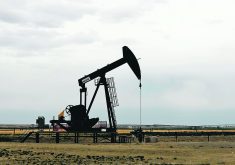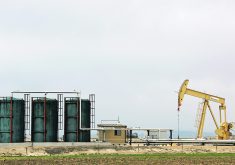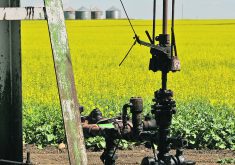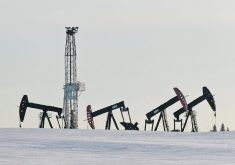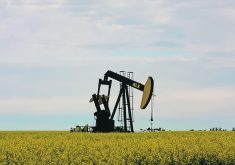Rural municipalities are collectively owed more than $253 million in unpaid property taxes by oil and gas companies
The Alberta government must review the province’s tax system to help ensure farmers are shielded from the ups and downs of oil and gas property taxes, says a rural leader.
“I think a transition away from our petro dollar addiction is definitely on top of mind for every municipal leader,” said Paul McLauchlin, president of the Rural Municipalities of Alberta. “I think the long game is actually looking at all of our tax structure and looking at economic diversification and growing our tax base.”
The key part farmers must play in such efforts is being demonstrated by Russia’s war on Ukraine, which is endangering the world’s food supply due to the central role of both countries as agricultural exporters. Products grown and raised by Alberta farmers will be needed more than ever, said McLauchlin.
Read Also

Why feds imposed EV tariffs
Moe and Kinew have a fight on their hands when it comes to eliminating the EV tariff. Canada has to worry about pissing off the U.S. and Mexico and hundreds of thousands of auto workers.
He called the agricultural sector “the most important industry on planet Earth right now.” However, in terms of property taxes, oil and gas companies provide about 60 percent of the revenue relied on by Ponoka County, where he is the reeve.
“Now, it’s going to become 10 to 20 percent sometime in the future 10 years from now, and so we as municipalities need to answer the simple questions, ‘what do we have, what do we need, and how are we going to pay for it?’ And I think that’s the journey we’re all on right now.”
Rural municipalities are responsible for more than 70 percent of Alberta’s roads and 60 percent of its bridges. Although oil and gas companies also use this road network to get to their wells, farmers depend on it to receive supplies, travel to their fields and get their goods to market.
Despite soaring profits enjoyed by the energy industry, rural municipalities are collectively owed more than $253 million in unpaid property taxes by oil and gas companies, up 213.2 percent from about $81 million in 2018.
McLauchlin said about $143 million has been written off as unrecoverable because the companies that owe the taxes are no longer in existence or went bankrupt. It has left rural Albertans in a situation he called “hard to imagine. This wasn’t a problem in 2015. I rarely even heard of this… and it’s just become such a serious issue.”
“And the conversation I have with a lot of people is ‘it’s a volatile industry — to make those key policy changes to ensure this never happens again, do it now.’”
Any shortfalls in property taxes must be paid by rural landowners such as farmers to fund core infrastructure and operations.
“Not only is this unfair to municipalities, it is unfair to every rural taxpayer who must pay more or receive fewer services to offset those taxes not being paid by the oil and gas industry,” McLauchlin said in an earlier statement.
Rural leaders and the Ministry of Municipal Affairs are starting to discuss how to modernize the assessment of taxes, he said in an interview.
“And we don’t want to cause impairment to the agricultural industry because, as I said earlier, if there’s any time Alberta’s agricultural industry needs to help the world, it’s now.”
At the urging of the provincial government, rural municipalities agreed to several tax breaks in 2020 for Alberta’s then-ailing oil and gas industry. They included a three-year tax holiday for new wells during the 2022 to 2024 tax years.
However, the industry’s recent recovery is being reflected by the number of new wells, which increased 135 percent in 2021 compared to the previous year, a trend the RMA expects will continue. More drilling rigs and a greater demand for maintenance at older wells are placing a greater strain on existing municipal roads and bridges.
There is also a need to upgrade or add new roads and bridges to reach previously untapped resources. “Our cash flow has decreased, but the exploration has increased, so who pays for that?” said McLauchlin.
During the RMA’s recent convention, Alberta premier Jason Kenney thanked rural municipalities for being patient.
“So, you were patient, we were patient, but at these commodity prices, there’s no more excuses. These companies have got to pay what they owe you, period, full stop. And we will work with you to make sure that that happens.”
Although the provincial government last year restored a special lien that rural municipalities can use to try to recover unpaid taxes, applying it to a company’s assets has proven complicated, said McLauchlin. Asset ownership can be unclear and the process can be difficult for municipalities to navigate.
Scott Johnston, press secretary for Municipal Affairs Minister Ric McIver, said in an April 8 email that the province understands the frustration and it is working with industry and municipal stakeholders to find a solution.
Recent data suggests 95 percent of taxes owed by energy companies are being paid, Alex Puddifant, press secretary for Energy Minister Sonya Savage, said in an email April 8.
However, the provincial government revised a directive in December that allows the Alberta Energy Regulator (AER) to consider unpaid municipal taxes and surface lease payments when approving new projects, he said.
Thousands of farmers and ranchers have not been paid money they are owed by oil and gas companies for having wells on their land.
“We firmly believe that companies must pay the taxes owed to municipalities and rent owed to landowners,” said Puddifant.
During its recent convention, the RMA passed a resolution stating the AER is best positioned to address the tax issue, and that the “minister of energy has the power to direct the AER to build this requirement into their regulatory process.”
McLauchlin said the problem is that the AER is relying on companies to self-report their tax performance and does not see itself as the right body for tax enforcement.
“And also, the other important piece is the transfer of assets from companies to ensure that unpaid oil and gas taxes are paid prior to the transfer of assets from company A to company B.”
Apart from such measures, one of the best things the provincial government could do to take the pressure off rural municipalities is to improve bridge funding grants, he said. It would give them access to sufficient cash to replace bridges, decreasing the overall need for other grants and forms of tax.
Although Ponoka County has a population of about 9,000 people, it has a bridge liability of about $170 million, said McLauchlin.
“And I have $32 million in reserves that I keep adding to, but I keep replacing my bridges and I have a 20-year cycle on my bridges.”
County officials need to be confident they will still be able to pay for that ongoing liability despite an expected future decrease in oil and gas taxes.
“We have to make sure that’s balanced with not causing an increased impairment to the agricultural industry.”




